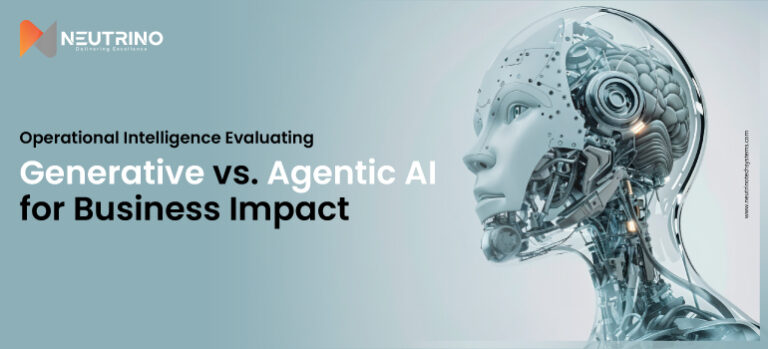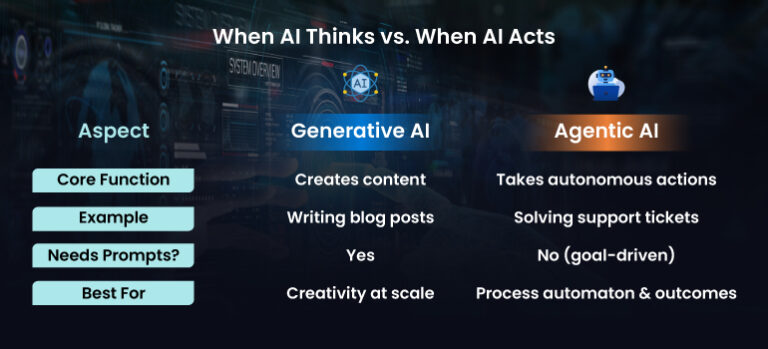Operational Intelligence: Evaluating Generative vs. Agentic AI for Business Impact

- June 10, 2025
A customer reaches out with a query, and an AI assistant promptly responds with the right information. In another scenario, an AI system identifies a supply chain delay, reroutes deliveries, updates internal systems, and alerts the team, all without manual intervention. These scenarios aren’t futuristic; they reflect the real-world impact of Generative AI vs Agentic AI, two fundamentally different approaches to AI already at work today.
As AI becomes embedded in the fabric of modern business, it’s important to recognize that not all AI solutions operate the same way. Some are designed to generate content or insights, while others are built to make decisions and take meaningful action.
In this blog, we’ll unpack the key differences between Generative AI and Agentic AI, and explore how each can support your business goals in distinct, impactful ways.
The AI Landscape is Evolving—Fast
In just a few years, AI has moved from experimental pilots to core business tools across industries. Enterprises are increasingly relying on AI to streamline operations, boost productivity, and enhance decision-making. Much of the attention has focused on Generative AI, with its ability to create content, code, and insights at scale. But there’s another powerful shift taking place less talked about, yet deeply transformative.
Agentic AI is quietly reshaping how businesses operate by going beyond content creation to take purposeful, autonomous action. It’s not just supporting workflows, it’s driving them forward.
Our recent feature on how Harnessing Agentic AI to Accelerate Enterprise Efficiency & Growth
We took a closer look at this shift in our recent blog, Harnessing Agentic AI to Accelerate Enterprise Efficiency and Growth, where we explored how Agentic AI is not just enhancing operations but fundamentally redefining how enterprises plan, execute, and evolve with greater autonomy and intelligence.
Generative AI—The Creator
Generative AI is designed to create, whether it’s writing marketing copy, generating code, producing images, or summarizing lengthy documents. It works by learning from massive amounts of data to generate content.
For businesses, it’s become a valuable tool for accelerating creative tasks, drafting first versions, and scaling content output with impressive speed. Teams use it to brainstorm campaign ideas, automate reporting, or even assist in software development.
But while it’s fast and capable, Generative AI isn’t autonomous. It requires clear prompts and doesn’t pursue goals on its own. Think of it as a highly skilled assistant; it can create remarkable things, but it still needs guidance and oversight.
Used wisely, it can significantly reduce manual effort and enhance productivity, especially in roles that balance creativity and repetition.
Agentic AI—The Doer
Agentic AI is built to act. Unlike Generative AI, which focuses on creating content, Agentic AI is goal-driven, designed to plan, decide, and execute tasks with minimal human input. It doesn’t just assist; it takes charge within defined boundaries, making real-time decisions based on evolving data.
In the enterprise world, Agentic AI is already powering end-to-end customer support resolution, streamlining supply chains, and enabling predictive maintenance without constant oversight. Its strength lies in autonomy; it doesn’t wait for instructions, it proactively works toward outcomes.
Think of it as a digital teammate who never tires, continuously learns, and always works with purpose. It’s not here to replace humans, but to free up teams from repetitive decision-making so they can focus on what matters most.
We touched on this shift in our March Tech Newsletter, where we explored how Agentic AI is evolving from simple task automation to driving intelligent business workflows.

Inside the Mind of Agentic AI
To truly grasp what makes Agentic AI distinct, it’s useful to look under the hood and understand how these systems actually function. Unlike traditional automation or reactive AI, agentic systems are built with intelligent architecture that enables them to act purposefully, make decisions, and adapt in real time.
Here’s a closer look at the core components that make Agentic AI work:
- Planning Modules
Agentic AI doesn’t just react, it creates a plan. These systems can break down complex goals into actionable steps, sequencing tasks much like a project manager would. - Memory Systems
They remember. Episodic memory helps agents recall specific past events, while semantic memory stores general knowledge. This memory structure allows agents to learn from past interactions and apply that knowledge to new situations. - Tool Usage and Integration
Agents don’t work in isolation. They use APIs, apps, and external databases similar to how a human might use different software tools to get a task done. - Context-Aware Reasoning
These systems can retrieve and apply the most relevant information based on the task at hand. With techniques like retrieval-augmented generation, they adapt dynamically to new data or changing environments. - Autonomous Decision-Making
Perhaps the most powerful trait agentic systems can act independently. They make decisions based on defined objectives and current context, without waiting for constant human input.
Generative AI vs Agentic AI: Finding the Right Fit for Your Business
When it comes to AI, it’s not about choosing sides. Most forward-thinking enterprises benefit from a hybrid approach that leverages Generative AI for content creation and brainstorming, while relying on Agentic AI for task execution and process optimization.
Think of Generative AI as a creative assistant, quick, clever, and great at drafting ideas. Agentic AI, on the other hand, acts more like a proactive manager, goal-driven, autonomous, and focused on getting things done.
To decide what fits best, start with your business objectives: Do you need to scale creative output, or are you aiming to automate complex workflows? Assess your data infrastructure. Agentic AI demands maturity in data quality and accessibility. And don’t overlook ethics: both require clear oversight, but Agentic systems especially need stronger governance.
According to a resource, AI could add up to $4.4 trillion in global productivity annually, but only with the right strategy in place. The key takeaway? Technology is only as valuable as the strategy behind it.
Wrapping Up: A Collaborative Future Ahead
Generative AI vs Agentic AI aren’t competing technologies—they’re complementary forces shaping the next era of intelligent business. One brings creativity and speed, the other brings direction and action. Together, they offer a powerful toolkit for organizations ready to evolve.
There’s no need for all the answers at once. What matters is a mindset of exploration, staying informed, asking the right questions, and aligning AI adoption with real business priorities.
At Neutrino, we’re harnessing the power of AI to help enterprises unlock smarter, faster, and more efficient ways of working. With hands-on experience across industries, we focus on building AI-driven solutions that go beyond automation, they’re designed to solve real challenges, support teams, and deliver lasting impact.
Our approach is rooted in the belief that AI should be both intelligent and human-centered. As Agentic AI emerges as a powerful new force in enterprise transformation, we see it as more than just a tool it’s a partner in building businesses that can adapt, learn, and grow By embracing this shift today, organizations can prepare for a future that’s not only more productive, but also more responsive, resilient, and ready for what’s next. At Neutrino, we’re here to help lead that journey.
